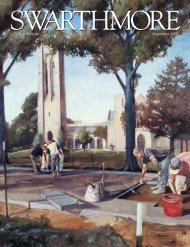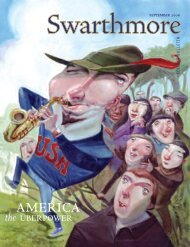A Walk in the Woods
Swarthmore College Bulletin (March 2001) - ITS
Swarthmore College Bulletin (March 2001) - ITS
You also want an ePaper? Increase the reach of your titles
YUMPU automatically turns print PDFs into web optimized ePapers that Google loves.
seen pileated woodpeckers. These big redheads with pile-driverbeaks are not really <strong>the</strong> size of a pterodactyl but can still give acasual hiker quite a start on a lucky day.The creek itself contributes mightily to <strong>the</strong> bird quality of <strong>the</strong>woods, Tim says. For example, he and Janet are able to show studentswood ducks, “probably <strong>the</strong> most spectacular of our nativeducks,” nest<strong>in</strong>g <strong>in</strong> logs near <strong>the</strong> water’s edge. A really lucky classgets to see duckl<strong>in</strong>gs leave <strong>the</strong>ir log nest with free-fall plops <strong>in</strong>towater if <strong>the</strong> nest permits. A hard land<strong>in</strong>g is OK too, Williamshastily assures me. “They bounce.”The less charm<strong>in</strong>g parts of <strong>the</strong> Crum also have <strong>the</strong>ir value,accord<strong>in</strong>g to Col<strong>in</strong> Purr<strong>in</strong>gton, assistant professor of biology, whoteaches plant physiology. “It’s really wonderful to have a field siteright outside my laboratory, so I send my students <strong>the</strong>re to learn<strong>the</strong> fun of field biology. On good days, <strong>the</strong>y return to <strong>the</strong> lab withstories featur<strong>in</strong>g poison ivy, nettles, and mosquitoes,” Purr<strong>in</strong>gtonsays. “But, on bad days, <strong>the</strong>y tell how <strong>the</strong>ir experiments were ru<strong>in</strong>edby forag<strong>in</strong>g deer and flash floods, or both.” Purr<strong>in</strong>gton says he’llkeep send<strong>in</strong>g <strong>the</strong>m out <strong>the</strong>re.The nearness of <strong>the</strong> woods makes fieldwork so much easier atSwarthmore than at schools that must transport students to woodsreserves at some distance from <strong>the</strong> campus. Those schools, by <strong>the</strong>way, <strong>in</strong>clude Bowdo<strong>in</strong>, Gr<strong>in</strong>nell, Oberl<strong>in</strong>, Vassar, and Williams.As Roger and I make our way out of <strong>the</strong> woods, I th<strong>in</strong>k about<strong>the</strong> alumni who have sent me such vivid memories of <strong>the</strong> Crum.(See <strong>the</strong> Bullet<strong>in</strong> Web site for a sample.) There’s extracurricular highj<strong>in</strong>x, some of it pr<strong>in</strong>table, but <strong>the</strong>re are also bits of up-close learn<strong>in</strong>gthat have endured for years. I easily th<strong>in</strong>k of three people whoe-mailed me about botaniz<strong>in</strong>g <strong>in</strong> <strong>the</strong> Crum for some long-ago class.The most distant of <strong>the</strong>se rem<strong>in</strong>iscences (see Bullet<strong>in</strong> Web site),complete with Lat<strong>in</strong> name and ecological context, seemed as wellpreserved as any botanical specimen—71 years later.As <strong>the</strong> light fades, Roger and I end up (where else) <strong>in</strong> <strong>the</strong> ScottAmphi<strong>the</strong>ater. Roger’s own graduat<strong>in</strong>g class faced <strong>the</strong> dreadedra<strong>in</strong> for Commencement and <strong>the</strong> result<strong>in</strong>g fold<strong>in</strong>g chairs <strong>in</strong> <strong>the</strong>field house. At <strong>the</strong> last m<strong>in</strong>ute, his class procession went AWOL enmasse, leav<strong>in</strong>g family and friends <strong>in</strong> suspense <strong>in</strong>doors. The Class of1983 marched uphill <strong>in</strong>to <strong>the</strong> soggy, drippy amphi<strong>the</strong>ater, andPresident David Fraser proclaimed <strong>the</strong>m graduates on <strong>the</strong> spot.Then <strong>the</strong>y retired to dry ground for <strong>in</strong>dividual handshakes anddiplomas.Part of <strong>the</strong> power of any place comes from <strong>the</strong> strength withwhich it pulls at our heartstr<strong>in</strong>gs, and <strong>the</strong> Crum has pulled longand hard today. In <strong>the</strong> ga<strong>the</strong>r<strong>in</strong>g darkness, it seems to me more asymbol than a place—a marker of some powerful aspect ofSwarthmore and my education <strong>the</strong>re, where <strong>the</strong> head and <strong>the</strong> heartcame toge<strong>the</strong>r, an experience, a memory, a walk <strong>in</strong> <strong>the</strong> woods.Then I remember someth<strong>in</strong>g else about symbolism that speaksto <strong>the</strong> potential of <strong>the</strong> College and its precious Crum: “The bestway to teach stewardship,” Roger said, “is by example.” TSusan Milius ’75, a former Scott Foundation <strong>in</strong>tern, writes for ScienceNews, a weekly news magaz<strong>in</strong>e about science and research.© RHODA MAURERThreats to<strong>the</strong> CrumThreats to <strong>the</strong> Crum <strong>Woods</strong> <strong>in</strong>clude bothman-made problems and botanical <strong>in</strong>vaders,<strong>in</strong>clud<strong>in</strong>g species from o<strong>the</strong>r parts of <strong>the</strong>world—or even from different ecosystems <strong>in</strong>North America.• Common reed (Phragmites australis)—Very aggressive reed that forms clumpswith great fea<strong>the</strong>ry tan topsEROSION• English ivy(Hedera helix)—Smo<strong>the</strong>r<strong>in</strong>g creeperthat does notstay on those iviedhalls. (Actually, ivyattacks build<strong>in</strong>gs,too.) Volunteerswork to remove itfrom trees.• Erosion—Development oncampus createsTERRY WILDmore runoff, caus<strong>in</strong>gerosion on <strong>the</strong>slopes lead<strong>in</strong>g to<strong>the</strong> creek. The gullybeh<strong>in</strong>d <strong>the</strong> LangMusic Build<strong>in</strong>g isnearly 6 feet deep.• Garlic-mustard(Alliaria petiolata)—Biennialmember of <strong>the</strong>GRAFFITImustard familywith coarse leavesand a spike of white flowers; monopolizeshabitats of such beloved spr<strong>in</strong>g favoritesas Dutchman’s britches and trilliums• Goutweed (Aegopodium podagraria)—Eurasian perennial herb that escapes gardensto form swaths of <strong>in</strong>vasive, jaggededgedfoliage; leav<strong>in</strong>g even a small piece ofroot when try<strong>in</strong>g to dig out a patchrenews <strong>the</strong> <strong>in</strong>vasion.• Graffiti—Pa<strong>in</strong>ted on rocks and carvedon trees, graffiti and o<strong>the</strong>r forms of vandalismare age-old problems <strong>in</strong> <strong>the</strong>woods.• Japanese knotweed (Polygonum cuspidatum)—AnEast Asian member of <strong>the</strong>buckwheat family that can shoot higherthan 10 feet• Lesser celand<strong>in</strong>e (Ranunculus ficaria)—Eurasian buttercup with tubers thatsprout low glossy leaves <strong>in</strong> forbidd<strong>in</strong>gpatches, well before native spr<strong>in</strong>g flowerstry to take advantage of early-seasonsunlight• Multiflora rose (Rosa multiflora)—Canclimb or grow freestand<strong>in</strong>g <strong>in</strong>to an airy,prickly shrub© RHODA MAURERNORWAY MAPLES• Norway maple(Acer platanoides)—Europeantree whose denseshade creates“Norways-only”zones. Removal is<strong>the</strong> only way tofight <strong>the</strong> <strong>in</strong>vader.—S.M.M A R C H 2 0 0 123
















